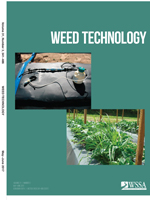Crop safety is an important consideration in determining PRE herbicide application, especially when multiple herbicide sites-of-action are used. This research examined relative corn injury as the result of PRE applications containing ALS- and/or HPPD-inhibiting herbicides to a sandy loam soil. Herbicide premixes containing clopyralid, flumetsulam, isoxaflutole, mesotrione, rimsulfuron, tembotrione, thifensulfuron, and thiencarbazone were applied at twice the labeled rate. In general, isoxaflutole alone was the safest herbicide evaluated, while PRE applications of rimsulfuroncontaining herbicides caused the most corn stunting, had a lower recovery rate, and lower yields. However, POST applications of mesotrione plus rimsulfuron stunted corn less than 2%. Although there was little correlation between corn injury and yield, growers should be aware of the other factors, such as soil texture and environment that may impact crop production.
Nomenclature: Clopyralid; flumetsulam; isoxaflutole; mesotrione; rimsulfuron; thiencarbazone; thifensulfuron; tembotrione; corn, Zea mays L.





